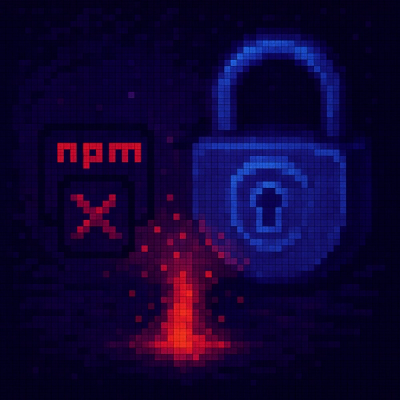
Security News
Software Engineering Daily Podcast: Feross on AI, Open Source, and Supply Chain Risk
Socket CEO Feross Aboukhadijeh joins Software Engineering Daily to discuss modern software supply chain attacks and rising AI-driven security risks.

blob-util is a Blob library for busy people.
It offers a small set of cross-browser utilities for translating Blobs to and from different formats:
<img/> tagsIt's also a good pairing with the attachment API in PouchDB.
Note: this is a browser library. For Node.js, see Buffers.
Topics:
Via npm:
npm install blob-util
ES modules are supported:
import { canvasToBlob } from 'blob-util'
canvasToBlob(canvas, 'image/png').then(/* ... */)
Or as a script tag:
<script src="https://unpkg.com/blob-util/dist/blob-util.min.js"></script>
Then it's available as a global blobUtil object:
blobUtil.canvasToBlob(canvas, 'image/png').then(/* ... */)
As of v2.0.0, a built-in Promise polyfill is no longer provided. Assuming you provide a Promise
polyfill, the supported browsers are:
Blob or the older BlobBuilder; see caniuse for details.Blobs (binary large objects) are the modern way of working with binary data in the browser. The browser support is very good.
Once you have a Blob, you can make it available offline by storing it in IndexedDB, PouchDB, LocalForage, or other in-browser databases. So it's the perfect format for working with offline images, sound, and video.
A File is also a Blob. So if you have an <input type="file"> in your page, you can let your users upload any file and then work with it as a Blob.
Here's Kirby. He's a famous little Blob.

So let's fulfill his destiny, and convert him to a real Blob object.
var img = document.getElementById('kirby');
blobUtil.imgSrcToBlob(img.src).then(function (blob) {
// ladies and gents, we have a blob
}).catch(function (err) {
// image failed to load
});
(Don't worry, this won't download the image twice, because browsers are smart.)
Now that we have a Blob, we can convert it to a URL and use that as the source for another <img/> tag:
var blobURL = blobUtil.createObjectURL(blob);
var newImg = document.createElement('img');
newImg.src = blobURL;
document.body.appendChild(newImg);
So now we have two Kirbys - one with a normal URL, and the other with a blob URL. You can try this out yourself in the blob-util playground. Super fun!

▸ arrayBufferToBinaryString(buffer: ArrayBuffer): string
Convert an ArrayBuffer to a binary string.
Example:
var myString = blobUtil.arrayBufferToBinaryString(arrayBuff)
Parameters:
| Param | Type | Description |
|---|---|---|
| buffer | ArrayBuffer | array buffer |
Returns: string
binary string
▸ arrayBufferToBlob(buffer: ArrayBuffer, type?: string): Blob
Convert an ArrayBuffer to a Blob.
Example:
var blob = blobUtil.arrayBufferToBlob(arrayBuff, 'audio/mpeg');
Parameters:
| Param | Type | Description |
|---|---|---|
| buffer | ArrayBuffer | - |
Optional type | string | the content type (optional) |
Returns: Blob
Blob
▸ base64StringToBlob(base64: string, type?: string): Blob
Convert a base64-encoded string to a Blob.
Example:
var blob = blobUtil.base64StringToBlob(base64String);
Parameters:
| Param | Type | Description |
|---|---|---|
| base64 | string | base64-encoded string |
Optional type | string | the content type (optional) |
Returns: Blob
Blob
▸ binaryStringToArrayBuffer(binary: string): ArrayBuffer
Convert a binary string to an ArrayBuffer.
var myBuffer = blobUtil.binaryStringToArrayBuffer(binaryString)
Parameters:
| Param | Type | Description |
|---|---|---|
| binary | string | binary string |
Returns: ArrayBuffer
array buffer
▸ binaryStringToBlob(binary: string, type?: string): Blob
Convert a binary string to a Blob.
Example:
var blob = blobUtil.binaryStringToBlob(binaryString);
Parameters:
| Param | Type | Description |
|---|---|---|
| binary | string | binary string |
Optional type | string | the content type (optional) |
Returns: Blob
Blob
▸ blobToArrayBuffer(blob: Blob): Promise<ArrayBuffer>
Convert a Blob to an ArrayBuffer.
Example:
blobUtil.blobToArrayBuffer(blob).then(function (arrayBuff) {
// success
}).catch(function (err) {
// error
});
Parameters:
| Param | Type | Description |
|---|---|---|
| blob | Blob | - |
Returns: Promise<ArrayBuffer>
Promise that resolves with the ArrayBuffer
▸ blobToBase64String(blob: Blob): Promise<string>
Convert a Blob to a binary string.
Example:
blobUtil.blobToBase64String(blob).then(function (base64String) {
// success
}).catch(function (err) {
// error
});
Parameters:
| Param | Type | Description |
|---|---|---|
| blob | Blob | - |
Returns: Promise<string>
Promise that resolves with the binary string
▸ blobToBinaryString(blob: Blob): Promise<string>
Convert a Blob to a binary string.
Example:
blobUtil.blobToBinaryString(blob).then(function (binaryString) {
// success
}).catch(function (err) {
// error
});
Parameters:
| Param | Type | Description |
|---|---|---|
| blob | Blob | - |
Returns: Promise<string>
Promise that resolves with the binary string
▸ blobToDataURL(blob: Blob): Promise<string>
Convert a Blob to a data URL string (e.g. 'data:image/png;base64,iVBORw0KG...').
Example:
var dataURL = blobUtil.blobToDataURL(blob);
Parameters:
| Param | Type | Description |
|---|---|---|
| blob | Blob | - |
Returns: Promise<string>
Promise that resolves with the data URL string
▸ canvasToBlob(canvas: HTMLCanvasElement, type?: string, quality?: number): Promise<Blob>
Convert a canvas to a Blob.
Examples:
blobUtil.canvasToBlob(canvas).then(function (blob) {
// success
}).catch(function (err) {
// error
});
Most browsers support converting a canvas to both 'image/png' and 'image/jpeg'. You may also want to try 'image/webp', which will work in some browsers like Chrome (and in other browsers, will just fall back to 'image/png'):
blobUtil.canvasToBlob(canvas, 'image/webp').then(function (blob) {
// success
}).catch(function (err) {
// error
});
Parameters:
| Param | Type | Description |
|---|---|---|
| canvas | HTMLCanvasElement | HTMLCanvasElement |
Optional type | string | the content type (optional, defaults to 'image/png') |
Optional quality | number | a number between 0 and 1 indicating image quality if the requested type is 'image/jpeg' or 'image/webp' |
Returns: Promise<Blob>
Promise that resolves with the Blob
▸ createBlob(parts: Array<any>, properties?: * BlobPropertyBag | string*): Blob
Shim for new Blob() to support older browsers that use the deprecated BlobBuilder API.
Example:
var myBlob = blobUtil.createBlob(['hello world'], {type: 'text/plain'});
Parameters:
| Param | Type | Description |
|---|---|---|
| parts | Array<any> | content of the Blob |
Optional properties | BlobPropertyBag | string | usually {type: myContentType}, you can also pass a string for the content type |
Returns: Blob
Blob
▸ createObjectURL(blob: Blob): string
Shim for URL.createObjectURL() to support browsers that only have the prefixed webkitURL (e.g. Android <4.4).
Example:
var myUrl = blobUtil.createObjectURL(blob);
Parameters:
| Param | Type | Description |
|---|---|---|
| blob | Blob | - |
Returns: string
url
▸ dataURLToBlob(dataURL: string): Blob
Convert a data URL string (e.g. 'data:image/png;base64,iVBORw0KG...') to a Blob.
Example:
var blob = blobUtil.dataURLToBlob(dataURL);
Parameters:
| Param | Type | Description |
|---|---|---|
| dataURL | string | dataURL-encoded string |
Returns: Blob
Blob
▸ imgSrcToBlob(src: string, type?: string, crossOrigin?: string, quality?: number): Promise<Blob>
Convert an image's src URL to a Blob by loading the image and painting it to a canvas.
Note: this will coerce the image to the desired content type, and it will only paint the first frame of an animated GIF.
Examples:
blobUtil.imgSrcToBlob('http://mysite.com/img.png').then(function (blob) {
// success
}).catch(function (err) {
// error
});
blobUtil.imgSrcToBlob('http://some-other-site.com/img.jpg', 'image/jpeg',
'Anonymous', 1.0).then(function (blob) {
// success
}).catch(function (err) {
// error
});
Parameters:
| Param | Type | Description |
|---|---|---|
| src | string | image src |
Optional type | string | the content type (optional, defaults to 'image/png') |
Optional crossOrigin | string | for CORS-enabled images, set this to 'Anonymous' to avoid "tainted canvas" errors |
Optional quality | number | a number between 0 and 1 indicating image quality if the requested type is 'image/jpeg' or 'image/webp' |
Returns: Promise<Blob>
Promise that resolves with the Blob
▸ imgSrcToDataURL(src: string, type?: string, crossOrigin?: string, quality?: number): Promise<string>
Convert an image's src URL to a data URL by loading the image and painting it to a canvas.
Note: this will coerce the image to the desired content type, and it will only paint the first frame of an animated GIF.
Examples:
blobUtil.imgSrcToDataURL('http://mysite.com/img.png').then(function (dataURL) {
// success
}).catch(function (err) {
// error
});
blobUtil.imgSrcToDataURL('http://some-other-site.com/img.jpg', 'image/jpeg',
'Anonymous', 1.0).then(function (dataURL) {
// success
}).catch(function (err) {
// error
});
Parameters:
| Param | Type | Description |
|---|---|---|
| src | string | image src |
Optional type | string | the content type (optional, defaults to 'image/png') |
Optional crossOrigin | string | for CORS-enabled images, set this to 'Anonymous' to avoid "tainted canvas" errors |
Optional quality | number | a number between 0 and 1 indicating image quality if the requested type is 'image/jpeg' or 'image/webp' |
Returns: Promise<string>
Promise that resolves with the data URL string
▸ revokeObjectURL(url: string): void
Shim for URL.revokeObjectURL() to support browsers that only have the prefixed webkitURL (e.g. Android <4.4).
Example:
blobUtil.revokeObjectURL(myUrl);
Parameters:
| Param | Type | Description |
|---|---|---|
| url | string |
Returns: void
Thanks to the rest of the PouchDB team for figuring most of this crazy stuff out.
npm install
npm run build
npm install
Then to test in the browser using Saucelabs:
npm test
Or to test locally in your browser of choice:
npm run test-local
To build the API docs and insert them in the README:
npm run doc
FilePond is a flexible and fun JavaScript file upload library that can handle multiple files and has extensive options for image preview, file validation, and drag and drop. It's more focused on the UI aspect of file handling compared to blob-util, but it also deals with Blob objects when processing files.
Pica is a library designed for resizing images in the browser with high quality and performance. While it primarily focuses on image processing, it works with Blob objects for loading and saving images. Compared to blob-util, Pica is more specialized in image manipulation.
FAQs
Utilities for working with Blob objects in the browser
The npm package blob-util receives a total of 3,744,117 weekly downloads. As such, blob-util popularity was classified as popular.
We found that blob-util demonstrated a not healthy version release cadence and project activity because the last version was released a year ago. It has 1 open source maintainer collaborating on the project.
Did you know?

Socket for GitHub automatically highlights issues in each pull request and monitors the health of all your open source dependencies. Discover the contents of your packages and block harmful activity before you install or update your dependencies.

Security News
Socket CEO Feross Aboukhadijeh joins Software Engineering Daily to discuss modern software supply chain attacks and rising AI-driven security risks.

Security News
GitHub has revoked npm classic tokens for publishing; maintainers must migrate, but OpenJS warns OIDC trusted publishing still has risky gaps for critical projects.

Security News
Rust’s crates.io team is advancing an RFC to add a Security tab that surfaces RustSec vulnerability and unsoundness advisories directly on crate pages.